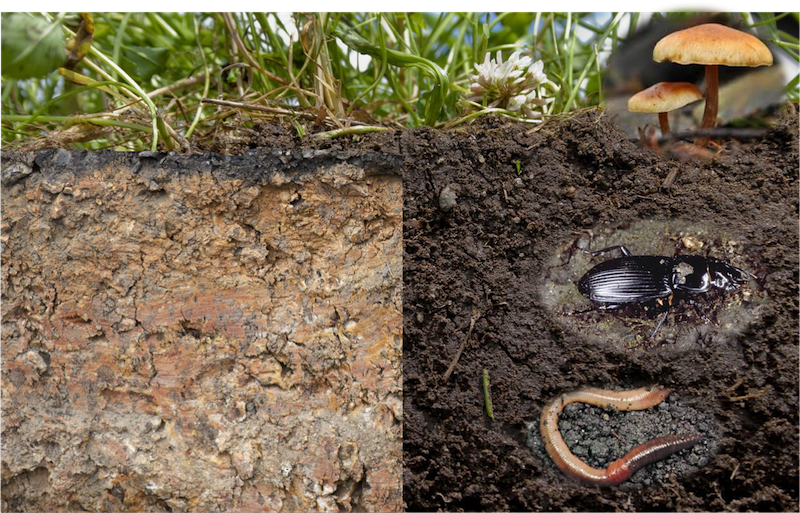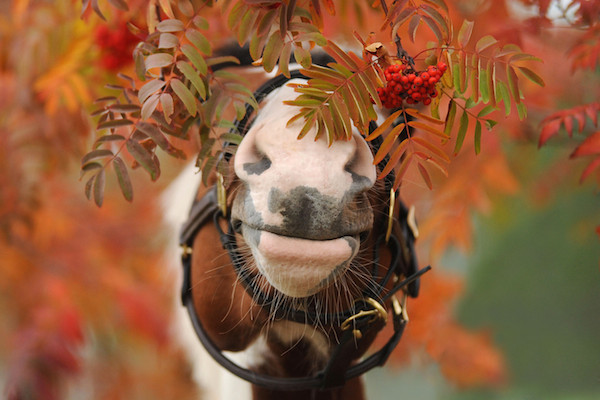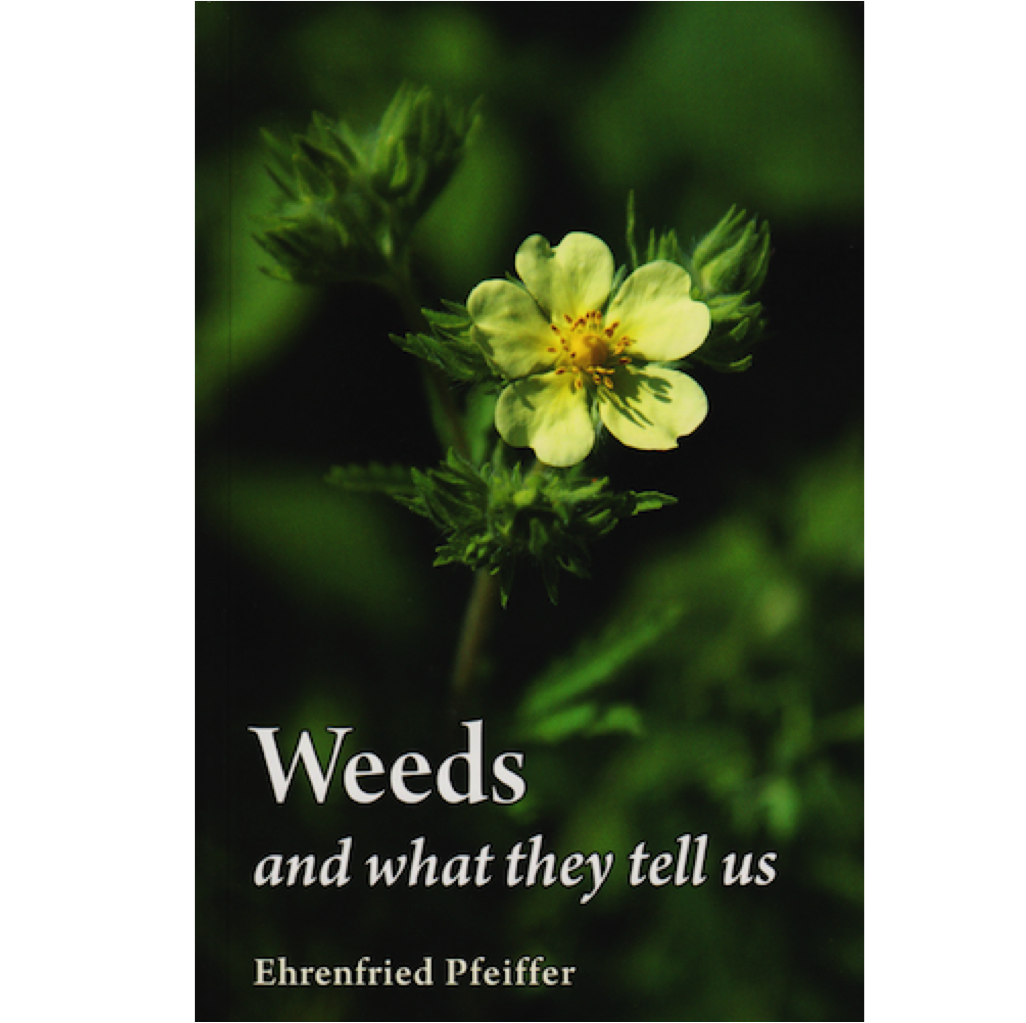In this brand new Equine Permaculture series, we will ‘dig deeper into soils’ and explore what soils are, how soil is formed, the different types of soil and how they sustain life through the soil-food-web.
Furthermore, we will discuss the importance of soil tests, in the lab and DIY, interpreting these soil test results, and how they may assist our soil and pasture management on the property.
Before we start digging up the dirt, let’s brush up on some facts about soil.
Soils are complex mixtures of minerals, water, air, organic matter, and numerous micro and macro-organisms that are the decaying remains of once-living things. It forms at the surface of land – think of it as the “skin of the earth.” Soil is capable of supporting plant life and is vital to life on earth. In many Equine Permaculture articles, we have focused on the importance of taking care of our soils, so we can grow healthy pastures to feed our horses.
The soil is perhaps the most overlooked, underrated, taken for granted, but major partner in growing plants. When managing pastures, how many horse and property owners have passed over getting to know their soil – reading up on soil facts – in favour of pasture planning and management?
What is soil?
Like many common words, the word soil has several meanings. The word “soil” is also known as “dirt”, “waste” or “earth”. In its traditional meaning, soil is the natural medium for the growth of plants. Soil has also been defined by the FAO (Food and Agriculture Organization of the United Nations) as a natural body consisting of layers (soil horizons) that are composed of solids (minerals and organic matter), liquid, and gases that occurs on the land surface, occupies space, and is characterised by one or both of the following: horizons, or layers, that are distinguishable from the initial material as a result of additions, losses, transfers, and transformations of energy and matter or the ability to support rooted plants in a natural environment.
Lengthy definition, that. But reading closely, soil has many things in it: nutrients; minerals; dead, decayed stuff; water and other liquids; and air and other gases. And–surprise?– soil has horizons just like the atmosphere and each is easily identifiable from the other. We will explain these in a bit more detail further in the article.
Soil is the end product of the combined influence of climate, topography, organisms (flora, fauna and human) on parent materials (original rocks and minerals) over time. As a result soil differs from its parent material in texture, structure, consistency, colour, chemical, biological and physical characteristics.
Soil is an essential component of “Land” and “Eco-systems” that both are broader concepts encompassing vegetation, water and climate in the case of land, and in addition to those three aspects, also social and economic considerations in the case of ecosystems.
Seven roles of soil
Soil performs many critical functions in almost any ecosystem (whether a farm, forest, prairie, marsh, or suburban watershed). There are seven general roles that soils play:
- Soils serve as media for growth of all kinds of plants.
- Soils modify the atmosphere by emitting and absorbing gases (carbon dioxide, methane, water vapour, and the like) and dust.
- Soils provide habitat for animals that live in the soil (such as groundhogs and mice) to organisms (such as bacteria and fungi), that account for most of the living things on Earth.
- Soils absorb, hold, release, alter, and purify most of the water in terrestrial systems.
- Soils process recycled nutrients, including carbon, so that living things can use them over and over again.
- Soils serve as engineering media for construction of foundations, roadbeds, dams and buildings, and preserve or destroy artefacts of human endeavours.
- Soils act as a living filter to clean water before it moves into an aquifer.

Soils are complex mixtures of minerals, water, air, organic matter, and numerous micro and macro-organisms that are the decaying remains of once-living things. It forms at the surface of land – think of it as the “skin of the earth.”
Soil Composition
So, soil is a mishmash of many things from all over the place—small pieces of broken rock, fallen leaves, dead critters, decomposed tree branches, and of course, decayed plants, to name a few. Additionally soil acts like a sponge storing 0.01% of the total water on Earth within its pores. To be exact, a typical healthy soil sample contains the following:
- 45% minerals
- 25% water
- 25% air
- 5% organic matter
Soil holds also many living organisms. An acre of soil can hold about 5-10 tons of living beings. If you would conduct a microbiology soil test you may find that one gram of soil could hold as much as 5,000-7,000 bacteria species.
Soil Formation
Soil formation typically happens over many years. Natural processes like weathering, erosions, rains, floods, hurricanes, thunderstorms, tornadoes and the like all contribute to soil formation. Lichen and plant roots also help break down rocks into little pieces to become part of the new soil.
Because of the different materials and processes that affect its formation, soil comes in different colours and textures. Soil could have such lively colours as red, yellow and white but most of the time, soil is black, brown or grey. Due to the sand, silt, clay and other mineral particles in it, soil could be smooth, creamy, rough, crumbly and sticky to the touch.
Parent materials
Soil minerals form the basis of soil. They are produced from rocks (parent material) through the processes of weathering and natural erosion. Water, wind, temperature change, gravity, chemical interaction, living organisms and pressure differences all help break down parent material. The types of parent materials and the conditions under which they break down will influence the properties of the soil formed. For example, soils formed from granite are often sandy and infertile. On the other hand, basalt under moist conditions breaks down to form fertile, clay soils.
There are five main interacting factors that affect the formation of soil:
1) Organisms
Soil formation is influenced by organisms (e.g. plants), micro-organisms (e.g. bacteria or fungi), burrowing insects, animals and humans. As soil forms, plants begin to grow in it; they mature, die and regrow. Their leaves and roots are added to the soil. Animals eat plants; their wastes and eventually their bodies are added to the soil. This begins to change the soil. Bacteria, fungi, worms and other burrowers break down plant litter and animal wastes and remains, to eventually become organic matter. This may take the form of peat, humus or charcoal.
2) Climate
Climate (rainfall, temperature and wind) influences the rate of weathering and also affects plant growth. Temperature affects the rate of weathering and organic decomposition. With a colder and drier climate, these processes can be slow, but with heat and moisture they are relatively rapid. Rainfall dissolves some of the soil materials and holds others in suspension. The water carries these materials down through the soil. This is known as leaching. Over time this process can change the soil, making it less fertile.
3) Topography
The shape, length and grade of slope affects drainage. Aspect determines the type of vegetation on a slope and the amount of rainfall received. These factors cause variation in soil formation.
4) Time
The length of time that soil materials have been weathered, influences soil properties. Minerals weathered from rocks are further weathered to form materials such as clays and oxides of iron and aluminum.
5) Natural erosion
Soil materials are progressively moved within the natural landscape by the action of water, gravity and wind for example: heavy rains erode soils from the hills and deposit it in lower areas, forming deep soils. The soils left on steep hills are usually shallower. Transported soils include alluvial (water transported), colluvial (gravity transported) and aeolian (wind transported) soils.
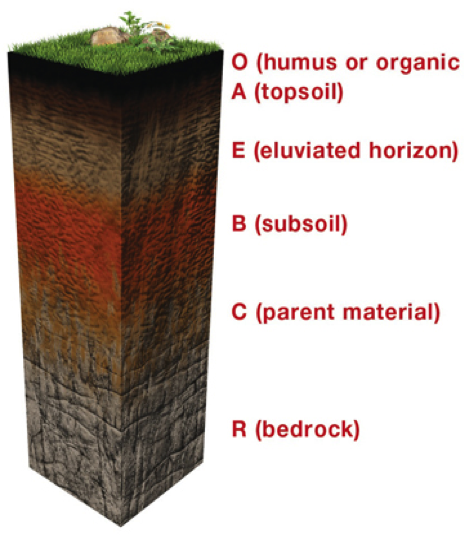 Soil horizon (soil layers)
Soil horizon (soil layers)
There are different types of soil, each with its own set of characteristics. Dig down deep into any soil, and you’ll see that it is made of layers, or horizons (O, A, E, B, C, R – see soil layer figure). Put the horizons together, and they form a soil profile. Like a biography, each profile tells a story about the life of a soil. Most soils have three major horizons (A, B, C) and some have additionally organic horizon (O), eluviated horizon (E) and/or bedrock horizon (R).
Horizon O (humus or organic) is the topsoil that we walk on. It’s one-inch thick and made up of decayed, organic stuff that feeds the soil and keeps it healthy. Horizon O is the most fertile, productive layer because it contains humus and lots of microorganisms that make nutrients available to plants.
Horizon A (topsoil) is the layer after Horizon O. It’s also part of the topsoil, composed of roots and beneficial microorganisms like mycorrhizae and fungi that feed on the waste materials shed off by roots. Of course, this horizon is also home to those hardworking critters -like earthworms, centipedes and dung beetles.
Horizon E (eluviated) is layer after Horizon A that some soil types may have such as older soils and forest soils. This layer is leached of clay, minerals, and organic matter, leaving a concentration of sand and silt particles of quartz or other resistant materials.
Horizon B (subsoil), the layer that follows, is a very tough layer. Rich in minerals that leached (moved down) from the A or E horizons and accumulated here. The soil is so hard that no root or critter can penetrate this barrier.
Immediately after that is Horizon C (parent material). These are rocks and old soil that form all the horizons above it. This layer contains primary bedrock, secondary materials from other places, old soil formations and the like.
Horizon R – (bedrock) is the last layer and consists of a mass of rock such as granite, basalt, quartzite, limestone or sandstone that forms the parent material for some soils – if the bedrock is close enough to the surface to weather. This is not soil and is located under the C horizon.
Soil types
Soil can come in many different soil types and identifying the type of soil you have will help to identify the types of plants that you can grow in your pastures. Soil can be categorised into sand, clay, silt, peat, chalk and loam types of soil based on the dominating size of the particles within a soil.
Sandy soil – are light, warm, dry and tend to be acidic and low in nutrients. Sandy soils are often known as light soils due to their high proportion of sand and little clay (clay weighs more than sand). These soils have quick water drainage and are easy to work with. They are quicker to warm up in spring than clay soils but tend to dry out in summer and suffer from low nutrients that are washed away by rain. The addition of organic matter can help give plants an additional boost of nutrients by improving the nutrient and water holding capacity of the soil.
Clay soil – are heavy soils that benefit from high nutrients. Clay soils remain wet and cold in winter and dry out in summer. These soils are made of over 25 % clay, and because of the spaces found between clay particles, clay soils hold a high amount of water. Because these soils drain slowly and take longer to warm up in summer, combined with drying out and cracking in summer, they can often test gardeners.
Silt soil – are light and moisture retentive soils with a high fertility rating. As silt soils compromise of medium sized particles they are well drained and hold moisture well. As the particles are fine, they can be easily compacted and are prone to washing away with rain. By adding organic matter, the silt particles can be bound into more stable clumps.
Peat soil – are high in organic matter and retain a large amount of moisture. This type of soil is very rarely found in a garden and often imported into a garden to provide an optimum soil base for planting.
Chalk soil – can be either light or heavy but always highly alkaline due to the calcium carbonate or lime within its structure. As these soils are alkaline they will not support the growth of ericaceous plants that require acidic soils to grow. If a chalky soil shows signs of visible white lumps then they can’t be acidified and gardeners should be resigned to only choose plants that prefer an alkaline soil.
Loam soil – are a mixture of sand, silt and clay that are combined to avoid the negative effects of each type. These soils are fertile, easy to work with and provide good drainage. Depending on their predominant composition they can be either sandy or clay loam. As the soils are a perfect balance of soil particles, they are considered to be great for pastures and gardens.
An important feature of soil is that it changes with depth.
Soil texture
Soil texture (e.g. loam, sandy loam or clay) refers to the proportion of sand, silt and clay sized particles that make up the mineral fraction of the soil. For example, light soil refers to a soil high in sand relative to clay, and heavy soils are made up largely of clay. Texture is important because it influences the amount of water that the soil can hold, the rate of water movement through the soil as well as its workability and fertility. For example, sand is well aerated but does not hold much water and is low in nutrients. Clay soils generally hold more water, and are better at supplying nutrients. Texture often changes with depth so that roots have to cope with different conditions as they penetrate the soil. A soil can be classified according to the manner in which the texture changes with depth. The three profile types are: uniform—same texture throughout the profile, texture-contrast—abrupt texture change between surface and sub-soil, gradational texture changes gradually from light to heavy down the profile.
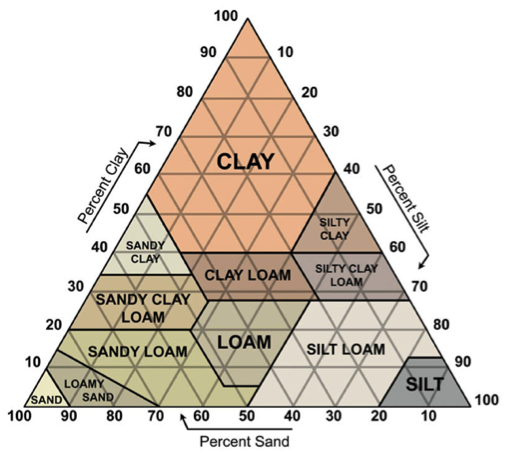 Structure:
Structure:
Soil structure refers to the way soil particles group together to form aggregates. These aggregates vary in size and shape from small crumbs through to large blocks. Very sandy soils are structure less because sand grains do not cling together. Some soils resemble a large solid, featureless mass—referred to as massive and have little or no structure. Good soils fit in between the two extremes. A well-structured soil breaks up easily into aggregates or peds with a definite shape (e.g. granular or blocky) and size (1-60 millimeters).
Organic matter helps give a soil good structure by binding soil particles together. Good structure is important, as it allows water to soak into the soil and excess water to drain away. It also allows air movement through the soil. Soil, air and water are vital for healthy plant growth and continued nutrient supply.
Colour
Soil colour is strongly influenced by humic (organic) materials, which are brown or black, iron oxides (red or yellow) and features of the parent material. Poorly drained soils may contain blue, grey and green colours.
Soil pH level
Soil pH is the measure of the acidity or alkalinity level of the soil. It affects plant growth, as it determines the availability of plant nutrients in the soil.
Soil pH is measured on a scale from 0-14, with 7 being neutral. A highly acidic soil can have as low as pH 3, while a highly alkaline soil can be close to pH 10. Most soils have a pH 6-8 range and plant growth is usually best in a soil of pH 6-7.
Nutrients
For plants to be healthy, they need a steady supply of nutrients from the soil. Nitrogen (N), phosphorus (P), potassium (K), sulfur (S), calcium (Ca) and magnesium (Mg), are required in relatively large quantities (macronutrients). Others are required in small quantities (micronutrients or trace elements), eg. copper (Cu), zinc (Zn) and manganese (Mn). A shortage or absence of any one of these essential nutrients can severely retard plant growth. Too many nutrients can be as bad as too few. The availability of nutrients is affected by the pH level of the soil. For example, in very acid soils, manganese and aluminum may be present in toxic concentrations. The nutrient status of a soil can be determined by a laboratory analysis of the soil or the plants that grow in it.
Dispersibility
This is characteristic of some clay rich soils that have a high concentration of sodium or magnesium in the clay fraction. A ‘sodic’ soil has a high sodium ion concentration. When these soils come into contact with water, they may become unstable and disperse. Dispersion in the surface soil leads to crusting and surface sealing, dispersion in the subsoil accelerates erosion and may lead to the formation of gullies and tunnels.
Permeability and porosity
Permeability is a measure of how easily water moves through the soil. At the surface, it affects the rate at which water can enter a soil, called the infiltration rate. It is affected by soil structure and texture. Porosity is the amount of space around mineral grains that can be filled by water or air, which contribute to a soil’s permeability. Particularly large pores that are visible are called macropores.
 Soil organic matter and soil carbon sequestration.
Soil organic matter and soil carbon sequestration.
Soil organic matter is the component of soil derived from all biological sources—whether living or nonliving. Soil organic matter is a vital indicator of soil health because of its impact on a variety of soil functions and properties. It provides the energy source for micro-organisms in the soil, is a reservoir of nutrients and improves the structural stability, water holding capacity and pH buffering capacity of the soil.
Soil organic matter content is difficult to measure directly but can be visually inspected. Laboratory tests actually measure soil organic carbon (SOC), which makes up about 58 % of total soil organic matter. Soil organic matter is made up of several pools that vary in their contribution to soil functions and their longevity in soil systems. Organic residue deposited in or on the soil is the most active pool, but may be rapidly lost (has low stability). Humus (made up of resistant compounds derived from decayed organic residues) is a slow, more stable pool. Charcoal is very stable, but is not biologically active, and therefore is an inert or passive pool. Soil cultivation and soil degradation result in losses of organic carbon which is released as CO2 into the atmosphere. Land clearing and overgrazing also contribute to the loss of soil carbon.
Improved soil management strategies such as crop stubble retention or leaf area management (for pasture) on the soil surface and reduced grazing pressure have the potential to increase the store of soil carbon, thereby acting as sinks for atmospheric carbon.
Understanding soil facts for better pasture management
The soil sustains most living organisms, being the ultimate source of their mineral nutrients. Soil management is an integral part of land management and may focus on differences in soil types and soil characteristics to define specific interventions that are aimed to enhance the soil quality for your pastures. For example many horse properties are established on overgrazed farmland that exposes subsoil. Many horse owners are not aware that this is not the correct soil layer that we need to work with to build pastures. We need to build a healthy top layer (top soil) before we can sustain healthy plants. Specific soil management practices are needed to protect and conserve our soil resources, as well as build more soil!
Soils are neither “good” nor “bad” because the distinction is often based on their intended use. However many soils have characteristics that make specific management interventions desirable to avoid problems for grazing purposes. Good management of soils assures that mineral elements do not become deficient or toxic to plants, and that appropriate mineral elements enter the food chain (soil – food – web). In the next edition we discuss in more detail the soil food web interaction and how this supports healthy pastures for our horses.
This article was published in the Horses and People Magazine February 2018
By Mariette van den Berg, PhD, BAppSc (Hons), RAnNutr

